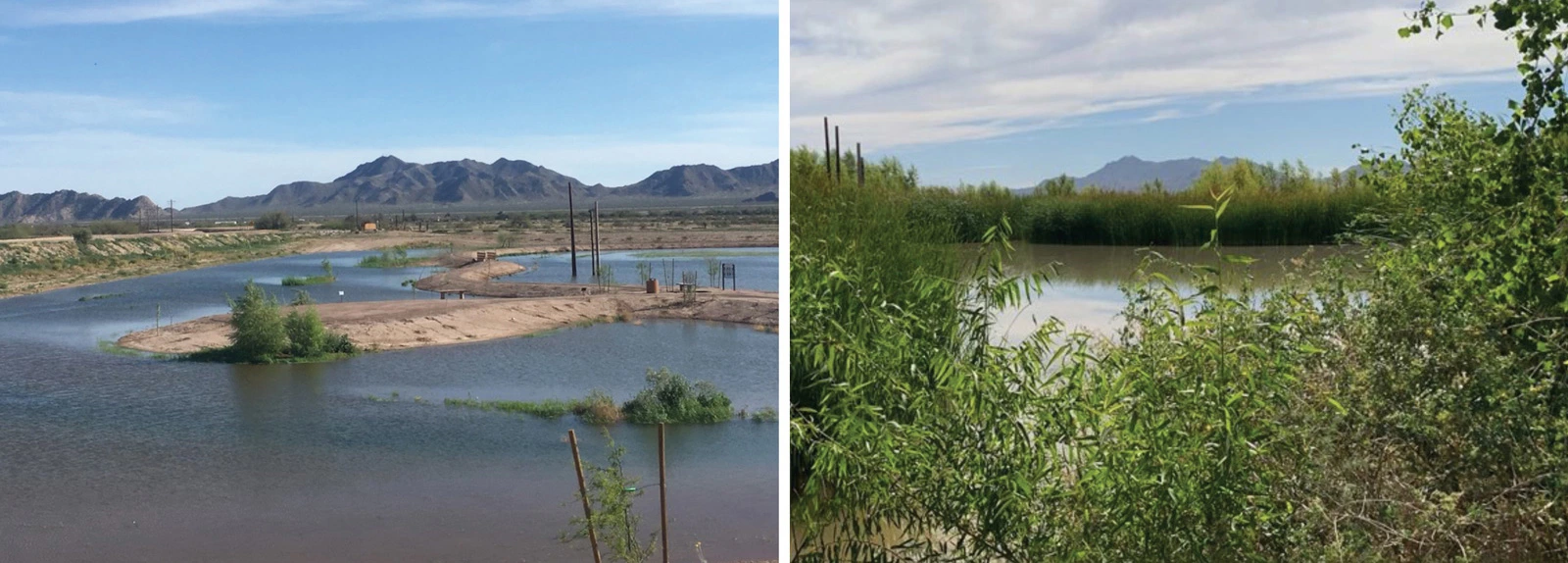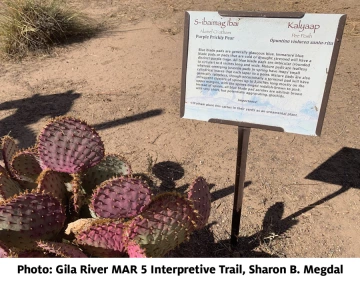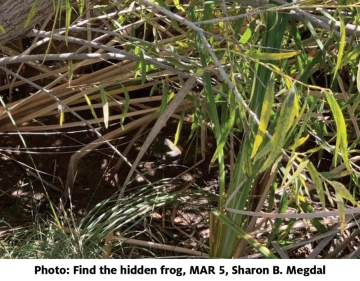
Photos (L to R): MAR 5 ceremonial opening, March 2019, and October 2021. Sharon B. Megdal
Managed aquifer recharge (MAR), the term commonly used for the practice of storing water underground, often for later recovery or use, is a widely deployed water management tool. Through legislative action and regulatory programs, Arizona has established a robust program of MAR project permitting and stored water accounting, which facilitates the utilization of MAR. Notably, the Arizona Water Banking Authority has stored millions of acre-feet of Colorado River water in aquifers for recovery during times of shortage. Tucson Water has positioned itself well to deal with cutbacks in Central

Arizona Project (CAP) deliveries by relying on recharge and recovery of CAP water to supply its customers and store the water it receives in excess of customer demand. And there are many other examples of how Arizona’s storage and recovery framework has enabled cost-effective approaches to meeting water management objectives.
On October 22, 2021, approximately 60 people who had attended the WRRC 2021 Annual Conference, Tribal Water Resilience in a Changing Environment, visited the Gila River Indian Community (GRIC)’s MAR 5 recharge project and Gila River Interpretive Trail. Field trip participants learned from GRIC Governor Stephen Roe Lewis how MAR 5 represents the legacy of his late father, Rodney “Rod” Blaine Lewis. Rod Lewis fought for the water that supports the environment, culture, education, and economy of the Community. His vision of reconnecting the Akimel O’odham - River People - to water led to their innovative water projects, of which MAR 5 is just one, though perhaps the most prominent.
What is particularly inspiring about MAR 5 is how it showcases GRIC’s integrated approach to managing its various water sources – one that is as close an example of integrated water resources management (IWRM) as I have observed. IWRM is defined by the Global Water Partnership as “a process which promotes the coordinated development and management of water, land and related resources in order to maximise economic and social welfare in an equitable manner without compromising the sustainability of vital ecosystems and the environment.” The MAR 5 project accomplishes these objectives through GRIC’s unique approach to using its water, including a voluntary partnership with the Arizona Department of Water Resources (ADWR). Although sovereign and not subject to ADWR regulations, by voluntarily agreeing to conform to ADWR groundwater storage permitting and accounting practices, GRIC has accumulated and marketed valuable long-term storage credits.

I was excited to have the opportunity to visit the site again. I had the honor of visiting MAR 5 for its ceremonial opening in March 2019, as well as two other times that same spring. The transformation of the site in the subsequent two and a half years shows what water means in the desert. The side-by-side photos above demonstrate the multi-benefit nature of replenishing aquifers and supporting plant growth. Flora provides locally sourced materials for traditional basket weaving. Interpretive signs inform people about the plant growth. The frog we observed while walking the Interpretive Trail is further evidence that water is life. (In the photo its body reflects the sunlight.)
My interest in MAR has spanned decades. Since the early 1990s, when I served as the executive director of the short-lived Santa Cruz Valley Water District, I have been intrigued by aquifer recharge as a mechanism for achieving water management objectives. I have worked on on-the-ground recharge projects. I have written book chapters, journal articles, and edited journal issues dedicated to MAR. For students in my spring semester water policy graduate class, I schedule a field trip to one or more recharge sites. I am participating in the planning of the 11th International Symposium on Managed Aquifer Recharge (ISMAR11), which will be held in April 2022 and will include a focus on governance and policy aspects of recharge. But no other recharge project has resulted in as much personal reflection as MAR 5.
“The frog does not drink up the pond in which he lives” is a proverb that I believe is attributed to the Lakota. I cite this proverb at the end of many of my presentations. My recent visit to MAR 5 underscores the truth that if you have water, you can support life in so many ways. We should be as smart as the frog.

Acknowledgement: I thank Governor Stephen Roe Lewis, David DeJong, Henrietta Lopez, Yolanda Elias, Kristina Morago, Sam Rector, and others who hosted our visit to MAR 5 and the Gila River Interpretive Trail.

